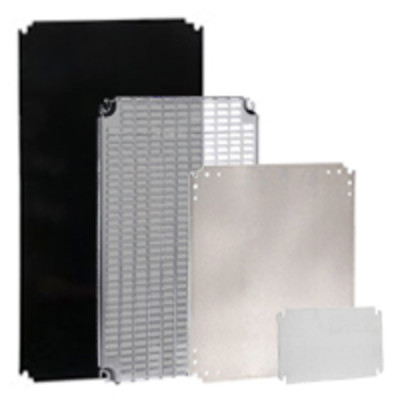What is an Enclosure Mounting Plate?
A mounting plate is a flat, rigid panel that installs inside an electrical enclosure. It creates a secondary surface specifically for mounting electrical components, separate from the enclosure walls. This seemingly simple addition offers a range of benefits for anyone working with electrical enclosures.
The first advantage is enhanced organisation. Mounting plates create designated zones within the enclosure, promoting a clean and uncluttered layout. This makes wiring easier, improves access for maintenance, and simplifies the entire panel building process.
Beyond organisation, mounting plates optimise space in an enclosure. They provide additional mounting surfaces, allowing for more efficient use of enclosure space. This is especially helpful for projects with a lot of components. Critical components like PLCs or relays can be mounted on the plate, freeing up valuable wall space for easier cable management and improved airflow.
In environments prone to heat buildup, mounting plates can become even more valuable. They function as heat sinks, drawing thermal energy away from sensitive components mounted directly on the enclosure walls. This can extend the lifespan and improve the overall reliability of your electrical system.
Finally, mounting plates offer a level of modularity. If you need to add or remove components in the future, the work can be isolated to the plate itself, minimising disruption to the overall panel layout.
Choosing the Right Material
Choosing the right material for your mounting plate depends on your specific project and environment.
Galvanised Steel is the industry standard for enclosure mounting plates, offering a strong and cost-effective solution. It provides structural support, making it suitable for heavy duty applications. The zinc coating on galvanised steel enhances its corrosion resistance and allows to withstand harsh environments. Additionally galvanised steel aids in grounding electrical components, promoting overall electrical system safety.
If superior corrosion resistance is your top priority, stainless steel is the ideal choice for your enclosure mounting plate. This material excels in areas with high humidity, chemical exposure, or wash down procedures. Stainless steel's inherent resistance to rust and corrosion makes it a long-lasting and reliable option.
Bakelite is a non-metallic option that stands out for its good insulating properties and heat resistance. This makes it a viable choice for applications requiring electrical isolation or those in high-temperature environments. Bakelite mounting plates can help prevent electrical shorts and protect components from heat damage. However it's important to note that bakelite may not be suitable for heavy-duty mounting, due to its lower strength compared to metal options.
Polyester mounting plates are durable and strong, and will provide a suitable mount for enclosures for years to come. Polyester mounting plates are not conductive, and so they are one of the preferred material used in rail applications.
Plywood mounting plates provide a dependable and economical solution for a range of non-critical applications. It's easily machinable for project customisation and provides a secure mounting base. However, consider its limitations: lower strength, moisture susceptibility, and fire risk. Plywood is ideal for temporary installations, dry environments or budget-conscious projects.
Get the Most Out of Your Enclosure
Enclosure mounting plates are a valuable tool for anyone working with electrical enclosures. By understanding their functionality and the available material options, you can optimise space, enhance organisation, and ultimately create a more efficient and reliable electrical system.
Here are some additional tips for choosing a mounting plate:
- Consider the plate's thickness and weight limitations.
- Ensure compatibility with your chosen enclosure.
- Look for pre-drilled holes for easier installation.
iLECSYS sell Micro perforated and Telequick mounting plates from Schneider:
Micro perforated plates feature tiny holes throughout their surface. These holes offer significant advantages, especially in environments prone to heat buildup. They allow the user to quickly assemble components onto the backplate using M4 tap-tite screws.Telequick steel plates streamline setup by offering installation of switchgear with drilling or screwing. Switchgear can simply be fixed in place with clip on nuts.
Whether you require standard mounting plates for your enclosures or need them customised with bespoke holes, iLECSYS has you covered. We offer a comprehensive selection and machining services to meet you exact requirements.
